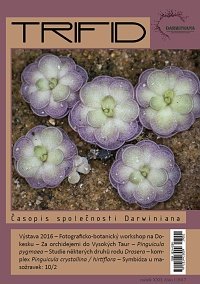Trifid 2017/1
- volume 22
- ISSN 1214-4134
- pages 56
- closing date 01.12.2017
Pinguicula pygmaea – new dwarf butterwort from Mexico
Adam Veleba
Shortly after a new sundew Drosera magnifica had been described we experienced another discovery. The trio of botanists Rivadavia F., Read E.L. a Fleischmann A. has introduced a new mexican butterwort Pinguicula pygmaea. It is a subtle, rare carnivoruos plant with a max. 2 cm in diameter rosette of flat, fragile leaves growing on gypsum. We bring a short resume of their discourse including pictures to readers of Trifid magazine.
Rigorous thesis „A study of selected species of Drosera genus“ (PhMr. Jaroslav Miksánek, 1969) in a context of today´s knowledge
Adam Veleba, Miloslav Macháček The expert text „A study of selected species of Drosera genus“ written by PhMr. Jaroslav Miksánek (1922–2008) was his rigorous thesis defended at the Faculty of Natural Science of Komenský University in Bratislava in 1969. The text was kindly provided by author´s grandson PhDr. Marek Šmíd who would like to remind his grandfather´s work and longtime practice as a responsible administrator in eminent Prague pharmacies. Adam and Slávek then tried to put the text in a contemporary context. The text itself has got three parts. Firstly the readers become aquainted with the Drosera genus from historical, geographical and taxonomical point of view. A large and extended chapter brings pharmacologic and pharmacognostic information. Closing part presents information about localities and experimental trials to acclimate Drosera capensis.
The Intricate Pinguicula crystallina/hirtiflora-complex
Andreas Fleischmann
The Pinguicula crystallina/hirtiflora-species-aggregate comprises rosetted perennial temperate butterworts of homophyllous growth type that are distributed in the Mediterranean and Asia Minor. Taxonomic history and difficulties of this intricate group of Pinguicula have been dealt in detail, yet still many questions remained regarding species concepts and circumscriptions. The species-complex is reviewed by the author, based on newly available data on distribution, morphological plasticity, and chromosome numbers, based on own field and herbarium studies, as well as on data gained from plants in cultivation.
Carnivorous plants symbiosis – 10. Fundamental role of symbiosis in evolution (Part 2)
Jiří Vítek
In the second part author closes his large article series about carnivorous plants symbiosis which we had an honour to be got to know during last years. Last chapter deals with symbiosis between prokaryotes and eukaryotes and between eukaryotes. Dr. Vítek has tried to bring readers of TRIFID closer to a field of biology of carnivorous plants that is quite rarely published in other popular science publications.
Exhibition of carnivorous plants (and other cool plants) 10.–19.6.2016 in hindsight
Patrik Hudec
We look forward to future both with hope and fears. No less important is to look back from time to time and balance what we have achieved. What was a success and what we could have done better. Do you still remember last year exhibition in the Botanical Garden of the Faculty of Natural Sciences of the Charles University in Prague?
Photographical – botanical workshop in Doksy area
Robert Hanzlík Jakub Štěpán has organized a photographical workshop associated with an excursion to several carnivorous plants habitats in Doksy area. The goal of the field trip was not only czech butterwort Pinguicula bohemica or sundews Drosera rotundifolia. There were also plenty of bladderworts, marsh grass of Parnassus (Parnassia palustris), marsh orchids – Helleborine (Epipactis sp.) leopard plants (Ligularia sp.). When you are in nature you have to take it with all. Although mosquitos were benignant for once, for arachnophobic people it was not a bed of roses. If you know Jakub you know that spiders are his favourite and we have to say very successful macro photography objects.
Searching orchids in The High Tauern
Vladimír Rudajev
While in the summer there are herds of Czechs attracted to sea migrating to south in direction to Italy or Croatia, there are still individuals who go astray to see a beauty of nature in The Alps. Vladimír takes us to a trip to The High Tauern to cheer up not only carnivorous platns lovers but mainly orchids lovers.
